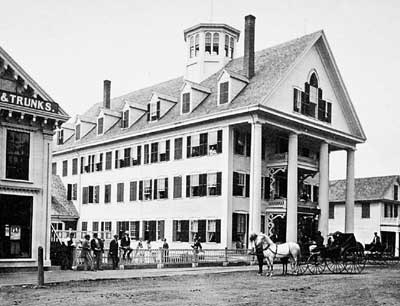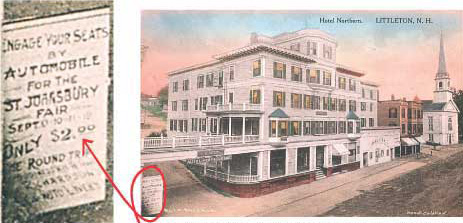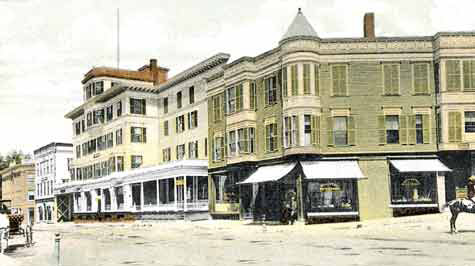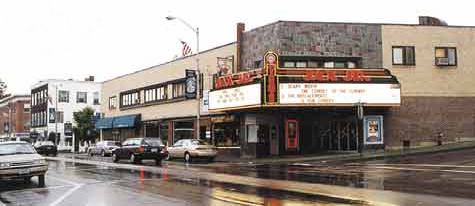
Littleton Coin & the Surrounding Area
Hometown History

At the heart of Littleton, Thayer’s Inn as it appeared at the turn of the last century. Note the unpaved streets and the horse and buggy carrying guests to their destinations.
For many years, I’ve collected 19th and early 20th century books, engravings, stereoviews, photos, and maps of the New Hampshire White Mountains where I live. While reading my copy of Chisholm’s White Mountain Guide-Book published in 1880, I found this reference to Littleton...
LITTLETON.
A bright little village, stretching along the Ammonoosuc, and slowly climbing the hills to the north, with the usual variety of quaint country stores, the usual group of small wooden churches, and the usual bank and weekly newspaper, — so Littleton appears to the casual visitor, who, if his turn of mind is practical, will see also a line of small factories along the rushing stream. It is indeed the most prosperous village in Northern New Hampshire, and might have been one of its great summer capitals if the pioneers of the last century [18th] had not changed its name of Chiswick to the name which it now bears. It is impossible for romantic or aesthetic emotions to be aroused by the word Littleton, which comes very near to being the culmination of the commonplace.
The writer goes on in a more complimentary tone...
There are beautiful prospects from the hills in this vicinity;...the vast panorama of mountains includes the Presidential peaks and the Franconia Range....So, in spite of its name and its enterprise, Littleton is yearly becoming more and more a favorite point with scenery-hunters. Near the centre of the village is that famous old inn, Thayer’s White-Mountain Hotel, whose Sunday dinners are famous in all northern New England.
In the year 2004, 124 years later, Thayer’s Hotel still stands, and Littleton is still a “bright little village.” Last May, Littleton was one of 5 communities in the U.S. to win the “Great American Main Street Award” sponsored by Osram Sylvania.
Littleton’s Main Street has been working for several years with The National Trust for Historic Preservation’s National Main Street Center, headquartered in Washington, D.C., to revitalize our downtown – with great results, which you will see if you visit us. To check out Littleton, visit the website www.golittleton.com
Just think, if the original settlers had not changed the name from Chiswick to Littleton, we’d probably be known as Chiswick Coin Company.
At the heart of Littleton, Thayer’s Inn as it appeared at the turn of the last century. Note the unpaved streets and the horse and buggy carrying guests to their destinations.

Circa 1909 Eli B. Wallace postcard of Northern Hotel and Premier Theatre
Old postcards are always interesting, especially when they are from your hometown. While the Methodist Church still stands proudly on Main Street, everything else shown here is gone. This Littleton landmark, the Northern Hotel, burned in 1924.
You can see the Premier Theatre in the center, and at the far left, the sign urging patrons of Israel C. Richardson’s Horse and Auto Livery to “Engage your seats by automobile for the St. Johnsbury Fair, Sept 10-11-12. Only $2.00 the Round Trip.” The St. Johnsbury fair was held in nearby St. Johnsbury, Vermont. Imagine spending two days pay – which is roughly what $2.00 represented in 1909 for the average Littleton worker – on a 30-mile automobile ride! Of course, in 1909, the automobile was a novelty in northern New Hampshire, and no doubt expensive to operate. Roads were pretty rough and muddy, too. Today’s Littleton – St. Johnsbury trip takes 25 minutes each way on scenic Interstate 93. I imagine Dave’s Taxi, Littleton’s present-day “auto livery” service (no, despite the name, it’s not mine) would do the trip pretty inexpensively.

Then and now, Littleton, NH. If you've ever driven through Littleton when you visited, you probably noticed the distinctive Jax Jr. Theatre (below). The picture postcard (above) shows Littleton's theatre as it looked in about 1908. Note the horse and buggy, left. Then, the cinema was known as the Premier Theatre and was also the site of the Northern Hotel, one of the best known inns of the day. Next door was E.D. Hervey's Little Hat Shoppe. Since Littleton is located in the White Mountains, it was only natural that in the 1950s the U.S. Eastern Amateur Ski Association (the largest division in the U.S. Ski Association) had its offices above the theatre. In a span of 25 years, the theatre burned three times. Each time, it was rebuilt and eventually became known as the Jax Jr. Theatre.


